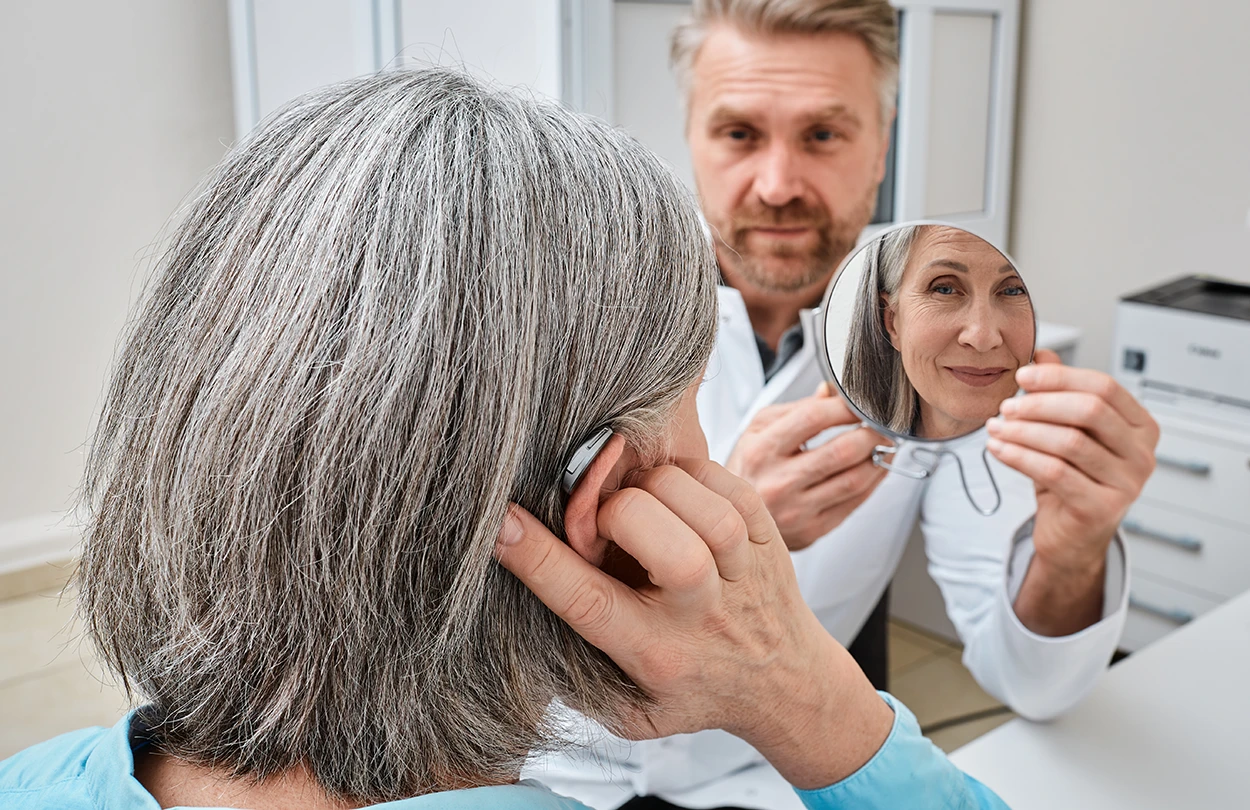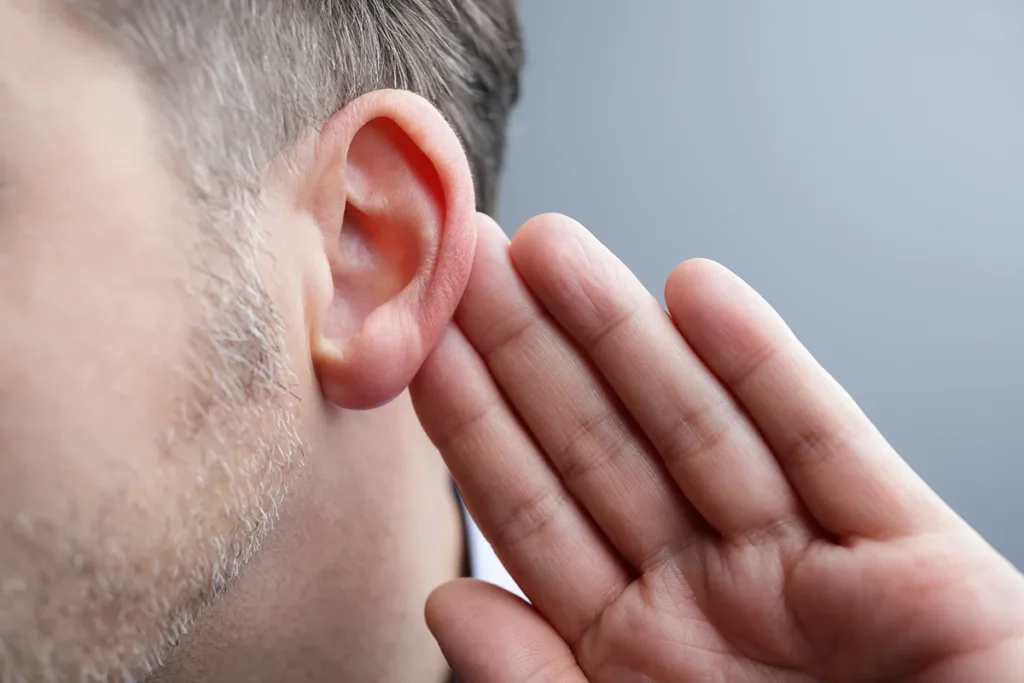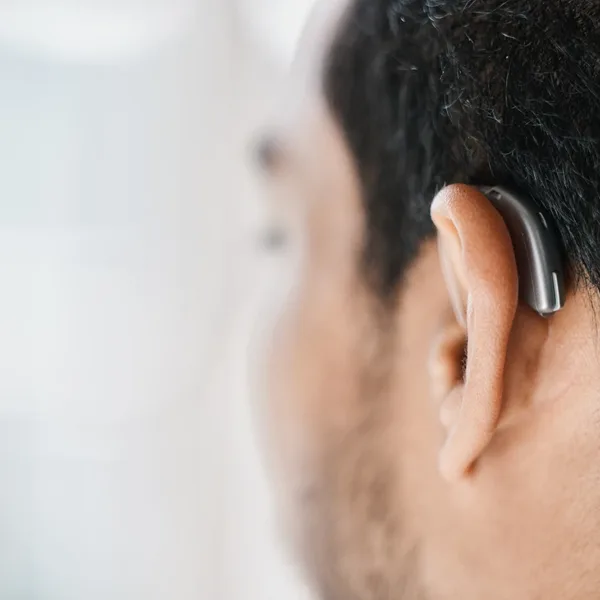
An estimated 1.8 million people in the U.S. have severe hearing loss.1 When left untreated, it can have a profound impact on communication, cognitive health, and quality of life. Fortunately, today’s prescription hearing aids are smarter, more powerful, and more advanced than ever before.
In this guide, we highlight the best hearing aid technology for severe hearing loss. Whether you’re exploring options for yourself or a loved one, this guide will walk you through the key features to look for and why.
Understanding Severe Hearing Loss
Hearing loss is classified into different degrees of severity, based on the lowest decibel (dB) range you can hear. With severe hearing loss, the softest sounds you can hear are between 71-90 dB.
In comparison, the softest sounds a person with a healthy hearing range can hear are between 10-20 dB. That’s about as quiet as a whisper or someone breathing. Additionally, normal conversations are usually around 60-70 dB. That means people with severe hearing loss may only hear someone speaking if they are standing close to them and talking loudly.
However, when hearing loss is this advanced, simply amplifying the volume of sounds isn’t always enough. Read on to learn why.
Why Sound Amplification Alone Is Not Enough

For someone with severe hearing loss, volume isn’t the only issue. In fact, simply amplifying sounds without improving clarity can actually make things even harder to understand, especially when it comes to speech.
Below, we explain why basic sound amplification falls short for severe hearing loss:
Louder Doesn’t Mean Clearer
When someone raises their voice, it doesn’t always make their words easier to understand. Speech can still sound muffled or jumbled, so you might be able to tell that someone is talking, but still struggle to understand exactly what they’re saying.
That’s because severe hearing loss often affects the ability to hear certain speech sounds, especially high-pitched consonants like “s,” “f,” or “th.” Simply turning up the volume doesn’t restore those missing sound signals or make speech any clearer.
Difficulty with Background Noise
Many people with severe hearing loss find it hard to follow conversations in noisy places. This is primarily because background noise can mask or drown out higher-frequency speech sounds. It can also make it even more challenging to pick out and focus on one specific sound.
In most real-world situations, we’re rarely in perfectly quiet settings. There are typically lots of other sounds going on around us: people talking, traffic outside, clinking dishes, footsteps, or even music.
Basic sound amplification turns the volume up on everything equally, including all that background noise. This can make it nearly impossible to follow a conversation when there’s a lot going on around you.
The Brain Needs More Support
Hearing isn’t just about your ears. Your brain does a lot of work to make sense of what you’re hearing. With severe hearing loss, the brain has to work even harder to constantly fill in the gaps of missed words.
Simply making sounds louder doesn’t give your brain the extra help it needs to make sense of what you’re hearing. With severe hearing loss, the underlying issue isn’t just about volume. It’s about missing critical sound information altogether.
There is No One-Size-Fits-All Solution
Our ears are as unique as fingerprints. Which means every person’s hearing loss is different, and so are their needs. What works for one person may not work for another.
Severe degrees of hearing loss require specialized technology tailored to your hearing needs and lifestyle, not just a louder device.
Key Hearing Aid Features for Severe Hearing Loss

Living with severe hearing loss can make it harder to stay connected to the people and moments that matter most. Whether you’re chatting with loved ones, enjoying a TV show, or listening in a group, hearing aids can help you follow conversation more easily and feel more engaged in your surroundings.
However, not all hearing aids are created equal. If you or a loved one has severe hearing loss, here are the most important hearing aid features to look for:
Speech Enhancement
People with severe hearing loss often struggle to hear typical speaking volumes and specific speech frequencies, making conversations sound muffled or incomplete. Speech enhancement technology is designed to make voices easier to understand by boosting the parts of speech that are most important for clarity.
How it works:
Advanced prescription hearing aids use digital signal processing (DSP) to detect the unique patterns of human speech. This technology converts sound inputs into digital data, allowing the device to separate speech from background noise and enhance clarity in real time.
Hearing aids with artificial intelligence (AI) use advanced algorithms to do this as well and can even learn to identify and prioritize specific voices that are familiar to you.
Automatic Noise Reduction
Noisy environments like busy restaurants, inside vehicles, or even lively family gatherings are especially difficult for people with severe hearing loss. Hearing aids with noise reduction features automatically suppress distracting background noise, so it’s easier to focus on what you actually want to hear.
How it works:
Noise reduction technology relies on advanced microphones and algorithms to separate speech from background noise in real time. Speech sounds are automatically amplified, while the unwanted noise is canceled out and suppressed.
This allows you to enjoy a more seamless and natural listening experience without being interrupted by unwanted background noise.
Custom Programming
With severe hearing loss, fine-tuned customization is essential for getting the most benefit from your devices. Custom programming ensures your hearing aids are optimized for your exact hearing needs, lifestyle, and listening preferences.
How it Works:
During a professional hearing test, your provider will identify the precise sound frequencies and volume levels you struggle to hear. They’ll use this information to fine-tune your hearing aid settings to suit your unique needs in real-world situations.
Once your base settings are in place, your specialist can then create multiple custom listening modes. These modes are designed to optimize your device performance in specific environments and situations you encounter in your daily life.
Custom programming ensures your hearing aids support you in real-world situations, so you can hear more clearly, communicate more easily, and feel more confident wherever you go.
Bluetooth Connectivity
For someone with severe hearing loss, digital audio like music, TV dialogue, and even phone calls can be a constant struggle to understand. Even with amplification, voices can still sound unclear or get lost in background noise. Bluetooth hearing aids combat this by delivering sound directly to your ears for clearer, uninterrupted sound clarity.
How it works:
Bluetooth-enabled hearing aids can wirelessly connect to your smartphone, tablet, TV, and many other electronics you may use regularly. Once connected, you can stream audio from these devices directly to your ears.
Your hearing aids automatically optimize the audio based on your settings, adjusting frequencies and volume levels to suit your specific needs. Whether you’re talking on the phone, watching a movie, or joining a video call, Bluetooth helps you stay connected and confident in real-time conversations.
Hearing Aid Smartphone Apps
Hearing aid apps like My Audibel and Thrive Hearing Control can be incredibly helpful tools, especially for people with severe hearing loss. These apps give you greater control over your hearing experience right from your smartphone, offering more convenience, comfort, and independence.
How they work:
Hearing aid apps connect to your device via Bluetooth, allowing you to adjust settings in real time, based on where you are and what you’re doing. With just a tap of your screen, you can adjust the volume, switch between different hearing modes, and even check your battery level. For people with severe hearing loss, these features can make a big difference in daily clarity and comfort.
Some advanced hearing aid apps can even track your daily steps, let you set reminders, troubleshoot device issues, and even translate languages. This technology puts you in control of your hearing health and turns your hearing aids into smart, responsive wellness tools.
Automatic Fall Detection and Alerts
Research shows that untreated hearing loss increases the risk of falls. In fact, older adults living with severe hearing loss are 5 times more likely to experience a fall.2 Hearing aids with fall detection offer both hearing loss support and an extra layer of personal safety, all in one.
How it works:
Advanced prescription hearing aids with fall detection are equipped with built-in motion sensors that can monitor body movement and orientation. If a sudden change consistent with a fall is detected, it can trigger an automatic alert to be sent to your pre-selected emergency contacts.
For anyone living with severe hearing loss, this feature adds a vital layer of safety, giving both you and your loved ones greater peace of mind.
Artificial Intelligence (AI) Technology
Severe hearing loss often requires more advanced sound processing technology to deliver clear speech and a comfortable listening experience. Hearing aids with built-in artificial intelligence (AI) can automatically adapt to your environment to optimize speech and sound clarity everywhere you go.
How it works:
AI hearing aids use artificial intelligence (AI) to automatically adapt to your ever-changing sound environment. They use advanced algorithms to learn from your daily interactions and tailor your hearing experience to your specific needs, preferences, and lifestyle.
This incredibly advanced hearing technology has redefined hearing loss care, providing the highest degree of clarity, comfort, and convenience available today.
Audibel AI Hearing Aids
Vitality AI

Go beyond better hearing with the industry’s most advanced AI hearing aid.
Learn More >>>
Intrigue AI

Experience AI technology that mimics the way our brain naturally processes sound.
Learn More >>>
Demo the Latest Hearing Aid Technology for Free at Audibel
Navigating daily life with severe hearing loss requires advanced technology and personalized care tailored to your specific needs. At Audibel, our specialists are here to help you find the best possible hearing loss solutions. With personalized care, you can enjoy better communication every day and a higher quality of life for years to come.
Find an Audibel hearing care clinic near you and schedule an appointment to demo our latest hearing technology for free.
References
- Goman, A. M., & Lin, F. R. (2016). Prevalence of hearing loss by severity in the United States. American Journal of Public Health, 106(10), 1820–1822. https://doi.org/10.2105/ajph.2016.303299
- Lin, F. R., & Ferrucci, L. (2012c). Hearing loss and falls among older adults in the United States. Archives of Internal Medicine, 172(4), 369. https://doi.org/10.1001/archinternmed.2011.728







Have a question or Comment?